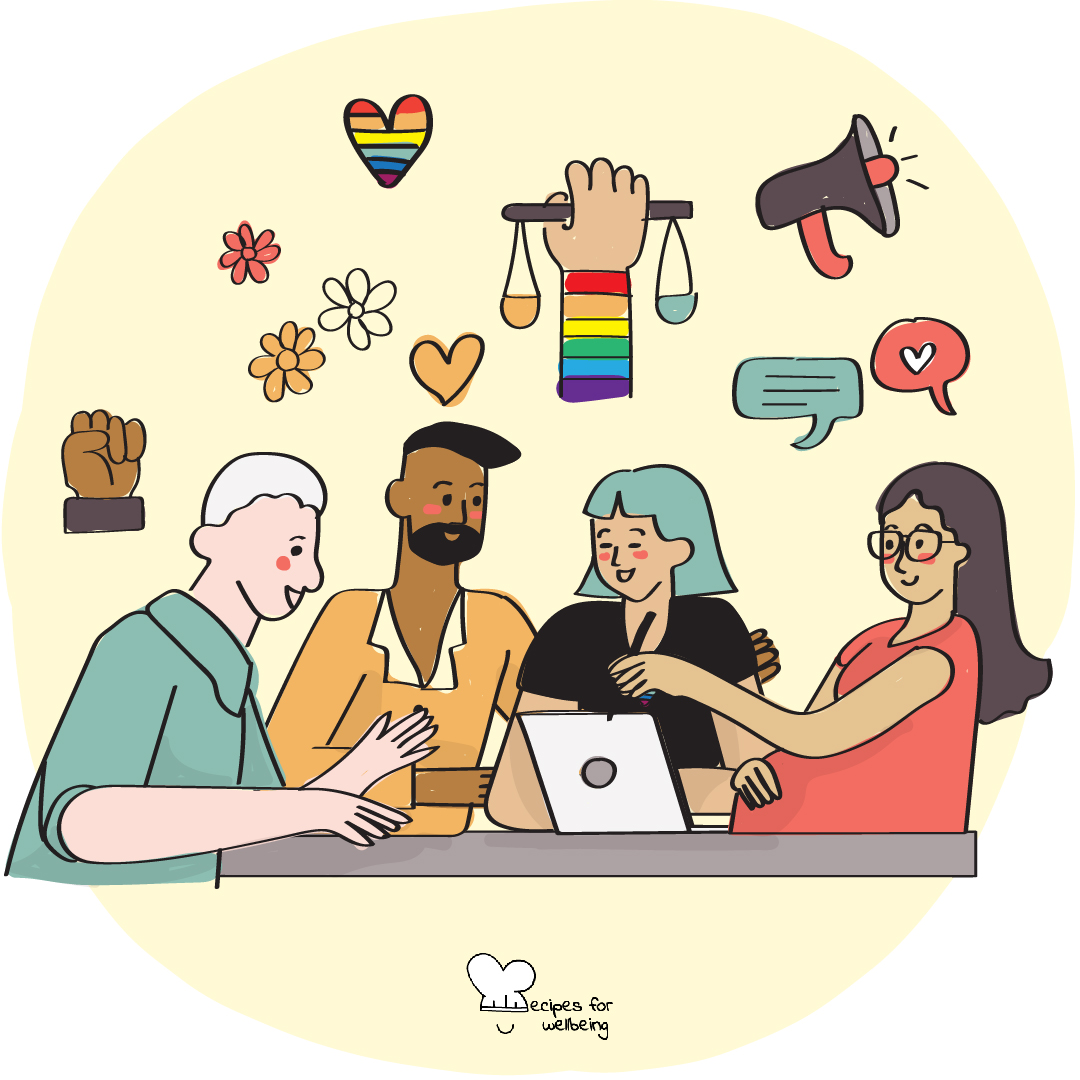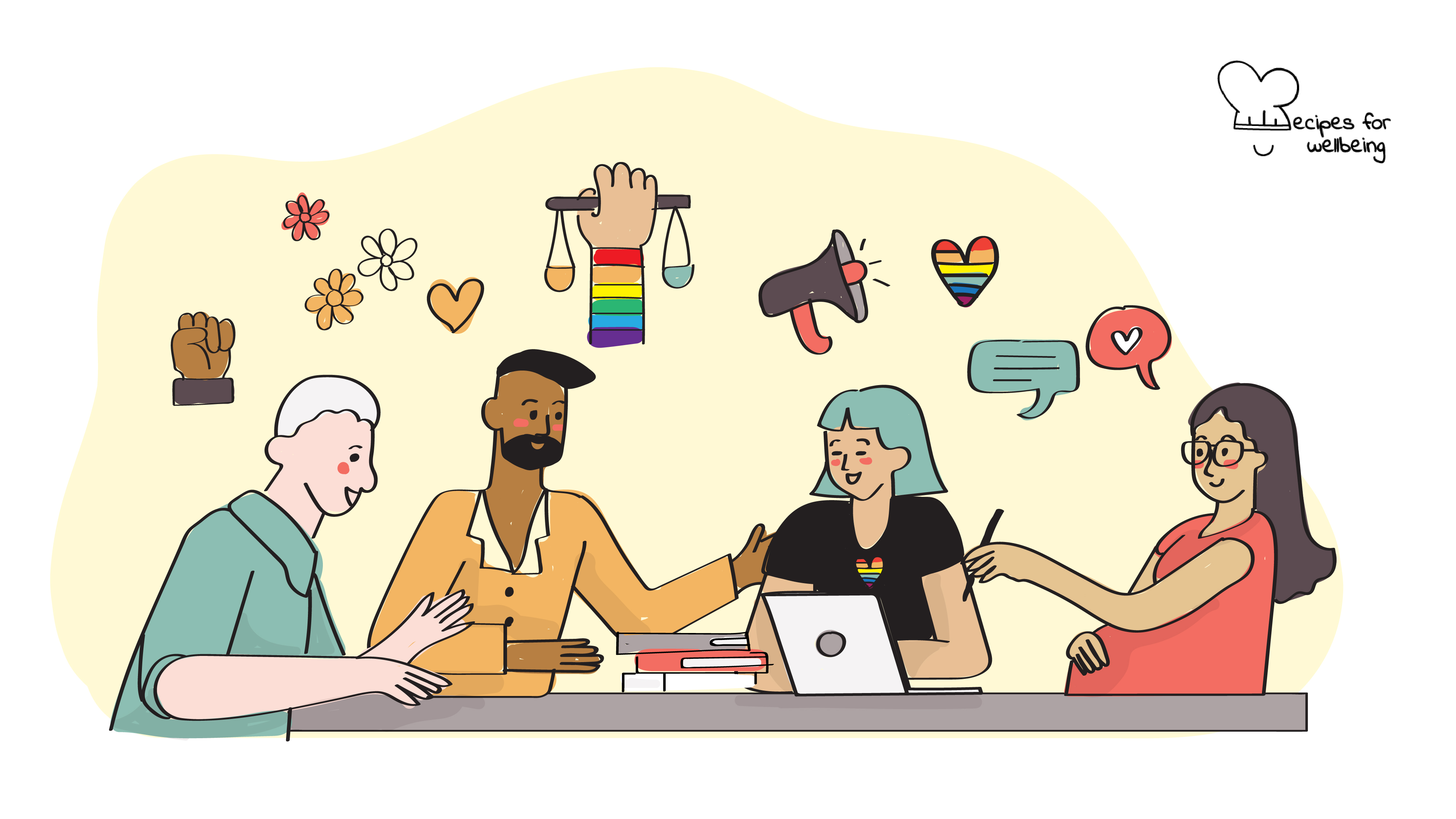
Strategies to support LGBTQIA2S+ folks in the workplace
The progress we have seen in the last few decades is astonishing, but we need to continue to work together to build a bright future for LGBT people. For each of us who breaks a barrier or cracks a ceiling, there’s someone else who needs a helping hand. ―Colin Druhan
👥 Serves: No limits of people
🎚 Difficulty: Medium
⏳ Total time: Ongoing
🥣 Ingredients: Open-mindedness, collaboration, and strategic thinking
💪 Nutritional values: Inclusion, Equity, Joy, Triumph, Safety

Strategies to support LGBTQIA2S+ folks in the workplace
📝 Description
Strategies for increased inclusion.
Diversity within a workplace is imperative and is about ensuring that your team is abundant with folks from varied backgrounds, experiences, and communities. Having diverse people is not a “tick box” exercise, but rather a way to learn, grow, and incorporate new ideas and voices.
How do you ensure that diversity is being adequately respected within the workplace? Inclusivity. Having an inclusive work culture cultivates an environment where people feel accepted, heard, and appreciated and where differences are celebrated. To have a diverse environment, inclusivity policies need to be in place.
In Europe, and worldwide, employment continues to be an area of life where LGBTQIA2S+ people experience significant discrimination. A 2018 survey from The European Union Agency for Fundamental Rights highlighted that 21% of respondents felt discriminated against at work, an increase from 19% in 2012. The 2018 survey also highlighted that 10% of people felt discriminated against when looking for employment and one in four respondents reported that they hid being LGBTQIA2S+ at their place of work.
Most employers want to adequately support LGBTQIA2S+ employees in the workplace. Yet, there are plenty of discrepancies and nuances, and many may neither grasp nor understand the challenges faced by LGBTQIA2S+ communities.
This recipe has been created by our wellbeing content writer collaborator Marissa Del Mistro and is inspired by the work of Alison Grenier, Head of Culture and Research at Great Place to Work and Jacq Hixson-Vulpe, Coordinator, LGBT Inclusion Index Pride at Work Canada.
👣 Steps
Step 1 – Anti-discriminatory policies
Do you have an anti-discrimination policy in place at your organisation? Does it include gender expression, sexual orientation, and gender identity?
Start by collaborating with your team. Include voices from the leadership team, employers, and stakeholders. You will want to work together in a collaborative and open-minded manner as you create a formal policy that outlines the organisation’s position on anti-disclination and the expected behaviour of each employer.
You will want to make it as inclusive as possible and provide examples of what homophobia, biphobia, and transphobia looks like. Most organisations opt for a “zero tolerance” approach rather than a “3 strikes” approach, which gives employers 3 chances before being reprimanded.
Once created, it should be assessed on a regular basis (every year or every other year) to ensure language is relevant, reflective of the organisation’s values, and meets human rights legislative requirements. The final policy should be easily accessible to every employer.
Step 2 – Gender-neutral pronouns
Gender-neutral pronouns are a great way to have everyone feel included and heard. To do this, you can do the following:
- Establish gender-neutral washrooms.
- Avoid using “he/she” for people who have yet to share their pronouns.
- Encourage the team to share their pronouns (but do not force people to share if they prefer not to).
- Ask team members to include their pronouns in email signatures, Zoom calls, and business cards, if they wish.
- Examine and adjust company policies to reflect gender neutrality. Gendered language can re-enforce gendered stereotypes, while not accurately reflecting the existence of genderqueer and gender non-binary folks.
Step 3 – Diversity training
To ensure your organisation’s diversity and inclusion is truly implemented, it is important to offer training for the entire team. Arrange an organisation-wide training, led by individuals from outside the organisation who are experts in the area.
This training should include a review of the organization’s discrimination and harassment policies, education on respectful and harmful language, reflection on biases, and review support plans for anyone who has experienced and/or witnessed discrimination and/or harassment.
Step 4 – Benefit packages
Benefit packages are important in modern-day work and should reflect the needs of everyone, including LGBTQIA2S+ employees and their unique needs. Package considerations for LGBTQIA2S+ employees:
- Medical coverage – inclusive of drugs related to HIV/AIDS such as PrEP, transition-related costs – including gender-affirmation surgery and IVF/fertility. Ensure any medical/health policies include same-sex spouses/partners.
- Parental/Caregiving Leave – including for adoption.
- Bereavement leave – to include the death of a domestic partner or/and the partner’s immediate family.
- Paid sick leave.
- Paid mental health days off.
Step 5 – LGBTQIA2S+ and allies internal support group
Support and encourage an internal group as a safe space for open conversation, support, and to discuss issues related to sexual orientation, gender identity and expression while working to end homophobia, biphobia, and transphobia within the workspace and beyond. This group can be open to allies, too.
Leadership/management can support this by not only attending (if everyone is comfortable) but by providing a space, time and allocating a portion of the budget for the group to invite speakers, purchase food, etc. These groups are a wonderful way to foster a sense of community within your team. It can also lead to the retainment of staff and encourage LGBTQIA2S+ employees to go for more senior leadership roles within the organisation.
This group should be regularly consulted for wider organisation issues such as policy reviews, development, partnerships, philanthropy, and other inclusion efforts. Consult our recipe “LGBTQIA2S+ allies in the workplace” for more ideas.
Step 6 – Put your money where your mouth is
As a team, volunteer and donate money regularly to various LGBTQIA2S+ organisations and/or promote LGBTQIA2S+-owned businesses in your town/city/community regularly.
Show up and participate in all pride related events – but don’t just stop there! Dedicate a few months of the year toward pride initiatives and to celebrate the community.

